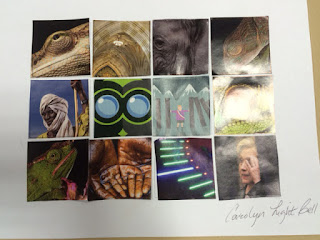Our session began with a task. Meryll asked us to try our hand at personifying wisdom either in words or image. I sat there stumped. My process is to circle around assignments until I find a way in. By the time I've found my entry, our time is usually up. Instead I decided to come at the assignment from a different direction. I began to describe my late mother, my model of wisdom, recounting the qualities that caused me to define her in this manner.
When we regrouped Meryll asked if our personification of wisdom had a gender. Many had in fact identified Wisdom as female, a natural lead-in to the Tanach which introduces us to Lady Wisdom in Proverbs 8 . We took a minute to read the passage and were asked to examine three aspects. What are the qualities of wisdom? Is there any theological issue that arises? Why a woman?
Wisdom is no shrinking violet. She stands at the gate of the city and shouts. She advocates for knowledge, uprightness, truth and offers words of fairness and clarity. Prudence is a companion to wisdom along with foresight. Resourcefulness, understanding and courage are counted among her attributes.
So why a woman? Hochma/Wisdom is in fact a feminine word in Hebrew. We noted verse 23 that talks of her in conjunction with the origin of the world, conjuring the idea of birth, echoed also in the word "fruit" in verse 19. Verse 30 intrigued us. Here Wisdom talks of her relationship with God. The word "Ahmon" can be translated in several ways, confidant, architect or a nurse who cares for a baby. Women were viewed as being on the border of civilization, on the edge, yet still within. Both exalted and vilified. One need only look to Proverb 7 and the Woman of Folly that it portrays, a bit of a hussy. Her counterpoint is presented as the Woman of Valour in Proverb 31.
We observed that many of the verses in Proverb 8 speak of wealth, perhaps metaphorically, but certainly this is not a wisdom that demands asceticism. Wisdom claims superiority over gold, silver and rubies and yet in verse 21 she speaks of filling the treasuries of those who love her. Her audience appreciated material goods which made this a meaningful metaphor. Wisdom knew her audience.
The origin of wisdom is ancient, the first of God's works of old (Proverbs 8:22). In Proverbs Wisdom claims existence prior to the earth, the heavens and the sea. Back to Genesis 1 where no mention is found. Yet another creation story has been introduced.
 |
| Athena |
Having described Wisdom in words, we turned our attention to the visual
 |
| Sidduri Sabitu-Epic |
 |
| Maat |
imagery used to connote Wisdom. The Greeks had Athena, often associated with an owl. Mesopotamians had Sidduri Sabitu-Epic of Gilgamesh and the Egyptians had Maat whose form is reflected in the hieroglyphic for wisdom.
 With that we shifted to our own visuals on wisdom. Lynda and Jay had asked us to bring magazines as source material and they now introduced us to a Visual Brainstorming exercise. We were offered a square template with which to frame images that we associated with wisdom. We then cut them out and pasted them into a square or oblong form composed of the squares we had selected. This was a very intuitive exercise and often quite visually pleasing. Some of us gravitated to certain colors, faces or line. I was surprised when one of my lab partners observed a theme of "holding" in my images, hands clasped around objects. Sometimes we are too close to our own creations to recognize the obvious.
With that we shifted to our own visuals on wisdom. Lynda and Jay had asked us to bring magazines as source material and they now introduced us to a Visual Brainstorming exercise. We were offered a square template with which to frame images that we associated with wisdom. We then cut them out and pasted them into a square or oblong form composed of the squares we had selected. This was a very intuitive exercise and often quite visually pleasing. Some of us gravitated to certain colors, faces or line. I was surprised when one of my lab partners observed a theme of "holding" in my images, hands clasped around objects. Sometimes we are too close to our own creations to recognize the obvious.
And a postscript from Meryll on our discussion...
If you’re intrigued by the image of Lady Wisdom, there are two contemporary Biblical scholars who wrestle with the imagery.
• "Women and the Discourse of Patriarchal Wisdom: A Study of Proverbs 1-9"
Carol A. Newsom in Gender and Difference in Ancient Israel. Ed Peggy L. Day
• Women and the Feminine in the Book of Proverbs
Claudia V. Camp
It is also recommended that you look at Lady Wisdom’s antithesis—Dame Folly—who appears in Proverbs chapter 7. You’ll notice the contrasting images such as Lady Wisdom appearing in public at the gate of the City, at the crossroads versus Dame Folly who emerges in the dusk of the evening and lurks at corners. Newsom labels the two portraits a diptych.
Proverbs is traditionally attributed to King Solomon. He is said to have written Song of Songs in his youth, Proverbs in his middle years, and Koheleth(Ecclesiastes) in his later years. This tradition aligns with some of the comments made during the Lab about wisdom’s dynamic property.
If you scan a few chapters of Proverbs beginning with chapter 10, you’ll see the practical wisdom expressed in aphorisms that characterizes most of the book. Similar wisdom literature with practical advice existed in ancient Egypt (The Teaching of Amenemope, The Instruction of King Meri-ka-re) and in Babylonia (Counsels of Wisdom).



No comments:
Post a Comment